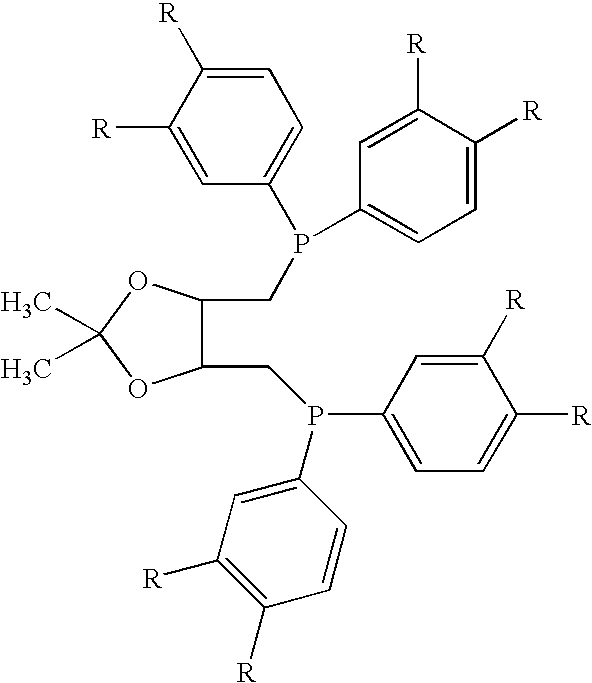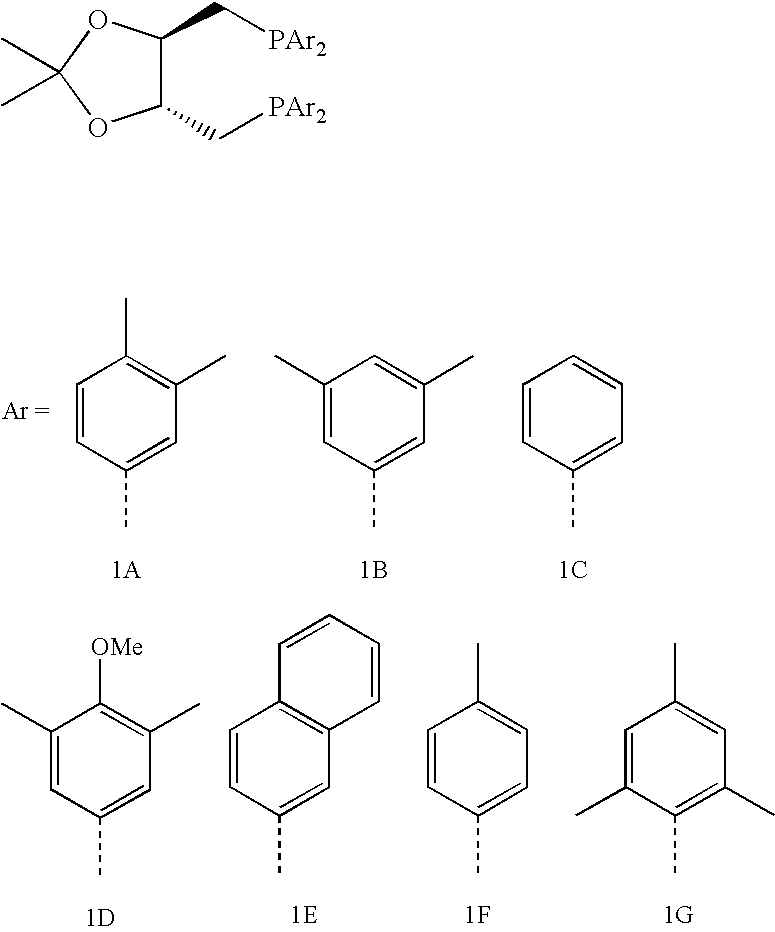Hydroformylation process
a technology of allyl alcohol and hydroformylation process, which is applied in the preparation of carbonyl compounds, physical/chemical process catalysts, organic compounds/hydrides/coordination complex catalysts, etc., can solve the problems of reducing the yield of bdo, severe adverse effect on process economics, and other co-products or byproducts formed, etc., to achieve high ratio
- Summary
- Abstract
- Description
- Claims
- Application Information
AI Technical Summary
Benefits of technology
Problems solved by technology
Method used
Image
Examples
example 1
Preparation of Diphosphines
[0027]1A, 1B. 1C. 1D. and 1E: Diphosphines 1A, 1B, 1C, 1D, and 1E of the following general formula are prepared as described below.
[0028]A solution of 2,2-dimethyl-4,5-bis[(toluenesulfonyloxymethyl)methyl]-1,3-dioxolane in dry / degassed THF (1 equivalent, 1.73 g, 3.7×10−3 moles of the dioxolane in 50 mL THF) is added drop-wise under argon to a solution of the appropriate lithium diarylphosphine (see formula above) in dry / degassed THF (2.3 equivalents in 100 mL THF). The mixture is heated at reflux for 2 hours, then cooled, and the solvent is removed under reduced pressure. The remaining solids are re-dissolved in dichloromethane, filtered though a silica bed, and the solvent is removed under reduced pressure to yield the 2,3-O-isopropylidene-2,3-dihydroxy-1,4-bis(diarylphosphino)butane.
[0029]Diphosphine 1A: 2,3-O-isopropylidene-2,3-dihydroxy-1,4-bis[bis(3,4-dimethylphenyl)phosphino]butane.
[0030]Comparative Diphosphine 1B: 2,3-O-isopropylidene-2,3-dihydroxy...
example 2
Hydroformylation Reaction using Diphosphines
[0036]Allyl alcohol is hydroformylated using diphosphines 1A-1E according to the following procedure:
[0037]A solution of the desired diphosphine (2 equivalents or 8.6×10−5 moles) in dry degassed toluene (15 g) is added to [Rh(CO)2(acac)] (1 equivalent or 4.3×10−5 moles) in a 100 mL Parr autoclave. The solution is flushed three times with a 1:1 CO / H2 mixture and then pressurized to 180 psig with the CO / H2 mixture. The autoclave is then heated to 65° C. with stirring, allyl alcohol (3.5 mL) is injected, and the autoclave is pressurized to 200 psig with the CO / H2 mixture. The autoclave is kept at a constant pressure of 200 psig, and the gas uptake of the reaction is monitored. When there is no further gas uptake, the autoclave is cooled and depressurized. The resulting solution is analyzed by gas chromatography to determine the products of the reaction. The reaction produces HBA, HMPA, and C3 products (n-propanol and propionaldehyde).
TABLE 1D...
PUM
| Property | Measurement | Unit |
|---|---|---|
| concentration | aaaaa | aaaaa |
| soluble | aaaaa | aaaaa |
| molar ratio | aaaaa | aaaaa |
Abstract
Description
Claims
Application Information
 Login to View More
Login to View More - R&D
- Intellectual Property
- Life Sciences
- Materials
- Tech Scout
- Unparalleled Data Quality
- Higher Quality Content
- 60% Fewer Hallucinations
Browse by: Latest US Patents, China's latest patents, Technical Efficacy Thesaurus, Application Domain, Technology Topic, Popular Technical Reports.
© 2025 PatSnap. All rights reserved.Legal|Privacy policy|Modern Slavery Act Transparency Statement|Sitemap|About US| Contact US: help@patsnap.com



